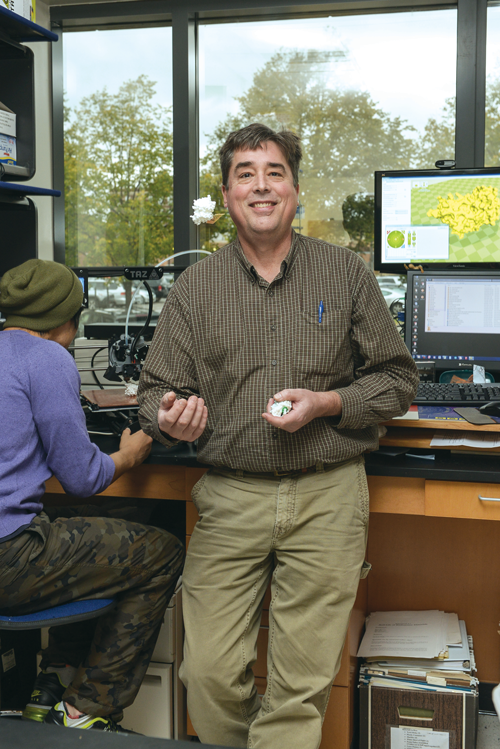
On a spring Thursday morning, climb the stairs to the Schaap Science Center biochemistry lab and you’ll find a dozen detectives at work. Each pair of student researchers is analyzing a protein that scientists don’t yet understand. Interpreting 3-D images, culturing bacteria and using gel electrophoresis to assess the size and behavior of particles, they are trying to discover how each protein’s shape determines its function.
Dr. Michael Pikaart, whose previous research focused on a protein that “turns genes on” in blood cell division and growth, has always had his Hope College students tackle real research in his biochem lab. That’s not the case, though, at every college. Some professors assign lab work to students that contributes to the professor’s own research about one particular protein — tasks that may not be truly exploratory. And even in upper-level science labs at many undergraduate institutions, students replicate experiments whose outcome is already known, with the goal of learning techniques that will prove useful later in careers or graduate school. Pikaart calls those “cookbook labs,” and he’s not a fan.
He is at work with a group of colleagues to create online materials that will make it easier for other professors to develop better laboratory experiences for their students. Faculty from seven colleges are participating in a National Science Foundation-funded five-year project to build a “how-to” library online that will be open-sourced for use by any teacher of biochemistry. The initial round of NSF grants came in 2015, followed by an additional three-year NSF grant in 2017 to help bring the project to fruition. In a weekly conference call, the professors update one another on their particular tasks, and they gather in person periodically to fine-tune the materials in development, which will include everything from YouTube videos to model timelines to resource lists. (Need to buy some bacteria? The vendor of choice is Arizona State University.)
Pikaart’s partners in this initiative teach at Rochester Institute of Technology, California Polytechnic San Luis Obispo, Oral Roberts, St. Mary’s University in Texas, Ursinus, Purdue and SUNY Oswego. Some are specialists in computational biochemistry, which Pikaart confesses is a stretch for him — just as his specialty in protein biochemistry is a stretch for some of his partners in this consortium. Hence their project, which will give biochemistry instructors tools to navigate topics outside their specialty area that will make it easier for them to launch lab experiences that challenge students with real research.
“Studies show that students who get involved in research show greater persistence through college — greater graduation rates, greater career success,” Pikaart reports. A hypothesis undergirding the project is that true research teaches the same techniques students would learn in less ambitious labs while also giving them a taste of how science works. In the process it cultivates students’ confidence, independence and initiative.
Experimental science involves uncertainty. Sometimes projects hit blind alleys. “Do we throw up our hands and say, ‘We don’t know how to do this’? Well, no. Supporting students in open-ended research projects helps them learn that sense of resilience. We want our medical folks to be able to figure stuff out,” he says.
Studies show that students who get involved in research show greater persistence through college — greater graduation rates, greater career success.
About half of his biochemistry lab students have their sights set on a health profession. Many of the others plan on graduate study in another scientific field.
Summer research can build independence and resilience for motivated science majors, “but we can’t deliver that to every student who comes through the door,” Pikaart notes. Integrating exploratory research into college courses entices students who might not assertively seek out such opportunities, and some discover they’re good at it — and find it fun. “If it’s one and done, that’s a win. If it’s a gateway to a career in science, that’s a win,“ he says.
In Hope College’s interdisciplinary major in biochemistry and molecular biology, students take organic chemistry and then move on to a two-semester biochem sequence: Biochemistry 1 in the fall, followed by Biochemistry 2 in the spring. Concurrent with Biochem 2, about half of the students in that class also take the optional biochem lab with Pikaart — some for the first half of spring semester and the rest during the second half. Their five hours in the lab each Thursday morning are a deep dive into sustained experimental work.
Roughly half of their research enterprise is examination of the structure of the proteins that they will study. There are tens of thousands of proteins, and images of many of them can be viewed online in public databases. Each visual component of what can look like a tangle of Christmas ribbon has a specific meaning, like letters in a word. Like MRI images, they record minute interactions at the molecular level. Through bioinformatics, a researcher can compare the amino acid sequence of an unknown protein to the structures of others whose function is already known.
Pikaart’s students’ hands-on lab research includes culturing bacteria in shaker flasks, breaking them open with ultrasound (or just “shaking the heck out of them”), and purifying the proteins the bacteria have made. In test tubes, they introduce molecules a protein might interact with, and observe how fast the solution changes color. Mistakes happen and are taken in stride. The steps for leading students through these and other exploratory processes will be spelled out in the materials that Pikaart and his fellow consortium members will solidify over the next few years.